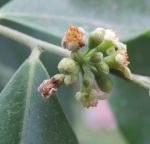 Also known as agarwood, this large evergreen tree is native to Northeast India, Bangladesh, Bhutan and parts of Southeast where it grows as an undercanopy tree mainly in the plains but also on hillsides and rideges, and by rivers and streams. It is a member the Thymelaeaceae family that also includes Daphne. The trees have a straight fluted stem and grow up to 160′ tall but are usually about 6o’. The glossy leaves are 2-3.5″ long leaves and linear-lanceolate to ovate-oblong. Small, inconspicuous, greenish yellow flowers appear on shortly peduncled umbels on the younger branches. The fruits are yellowish capsules. Photo Credit Wikipedia
Also known as agarwood, this large evergreen tree is native to Northeast India, Bangladesh, Bhutan and parts of Southeast where it grows as an undercanopy tree mainly in the plains but also on hillsides and rideges, and by rivers and streams. It is a member the Thymelaeaceae family that also includes Daphne. The trees have a straight fluted stem and grow up to 160′ tall but are usually about 6o’. The glossy leaves are 2-3.5″ long leaves and linear-lanceolate to ovate-oblong. Small, inconspicuous, greenish yellow flowers appear on shortly peduncled umbels on the younger branches. The fruits are yellowish capsules. Photo Credit Wikipedia
The Hebrew words ahalim and ahaloth are usually translated aloe but scholars think that the aloes of the New Testament are true aloes, Aloe succotrina, while those of the New Testament are Aquilaria agllocha, A. ovata or Santalum album (white sandalwood).
Psalms 45:8 (NIV) The greatness of an anointed (but unidentified) king is extolled.
“All your robes are fragrant with myrrh and aloes and cassia; from palaces adorned with ivory the music of the strings makes you glad.”
Proverbs 7.17 (NIV) Solomon tells a story of seduction in which an immoral woman lures a young man to her bed.
” I have perfumed my bed with myrrh, aloes and cinnamon.”
Song of Songs 4.14 (NIV) The bridegroom describes the garden of his beloved.
“nard and saffron, calamus and cinnamon, with every kind of incense tree, with myrrh and aloes and all the finest spices.”
Eaglewood likes full sun and average, moist soil with high rainfall and humidity in USDA Hardiness Zones 12-13. It is susceptible to damage by Cytosphaera mangiferae and boring insects. Propagation is by seed (with short viability). The tree is highly valued for a variety of uses especially its aromatic resin which is used in perfumery and has a long history of use in religious ceremonies and at funerals in the East. Other uses include as incense, medicine, paper, and flavoring for curry. Heavy exploitation has led to to the fear that the tree could become extinct.
The genus name, Aquilaria, comes from the Latin word aquila, meaning eagle. The specific epithet, agallocha, comes from a Latinized form of an ancient word meaning resinous.